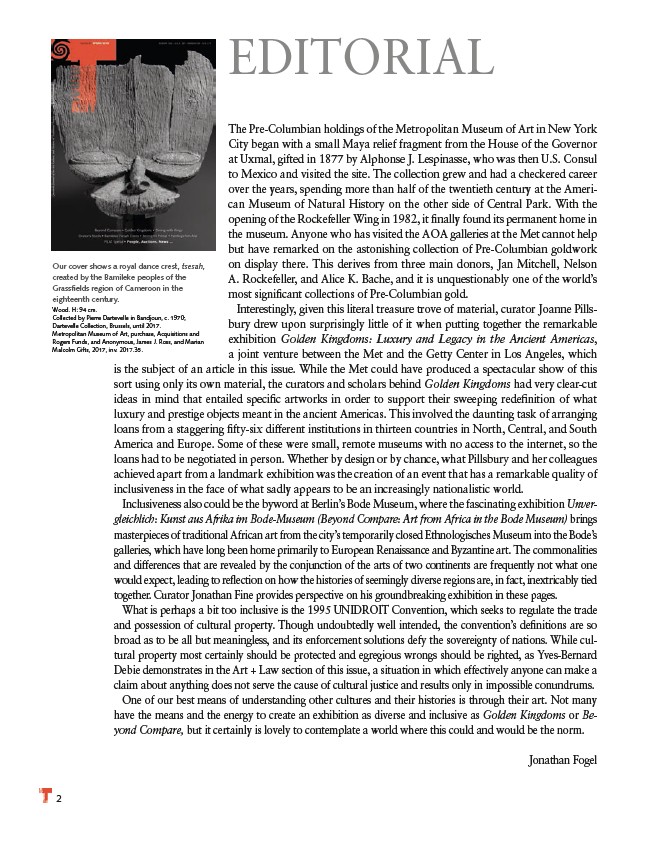
2
The Pre-Columbian holdings of the Metropolitan Museum of Art in New York
City began with a small Maya relief fragment from the House of the Governor
at Uxmal, gifted in 1877 by Alphonse J. Lespinasse, who was then U.S. Consul
to Mexico and visited the site. The collection grew and had a checkered career
over the years, spending more than half of the twentieth century at the American
Museum of Natural History on the other side of Central Park. With the
opening of the Rockefeller Wing in 1982, it fi nally found its permanent home in
the museum. Anyone who has visited the AOA galleries at the Met cannot help
but have remarked on the astonishing collection of Pre-Columbian goldwork
on display there. This derives from three main donors, Jan Mitchell, Nelson
A. Rockefeller, and Alice K. Bache, and it is unquestionably one of the world’s
most signifi cant collections of Pre-Columbian gold.
Interestingly, given this literal treasure trove of material, curator Joanne Pillsbury
drew upon surprisingly little of it when putting together the remarkable
exhibition Golden Kingdoms: Luxury and Legacy in the Ancient Americas,
a joint venture between the Met and the Getty Center in Los Angeles, which
is the subject of an article in this issue. While the Met could have produced a spectacular show of this
sort using only its own material, the curators and scholars behind Golden Kingdoms had very clear-cut
ideas in mind that entailed specifi c artworks in order to support their sweeping redefi nition of what
luxury and prestige objects meant in the ancient Americas. This involved the daunting task of arranging
loans from a staggering fi fty-six different institutions in thirteen countries in North, Central, and South
America and Europe. Some of these were small, remote museums with no access to the internet, so the
loans had to be negotiated in person. Whether by design or by chance, what Pillsbury and her colleagues
achieved apart from a landmark exhibition was the creation of an event that has a remarkable quality of
inclusiveness in the face of what sadly appears to be an increasingly nationalistic world.
Inclusiveness also could be the byword at Berlin’s Bode Museum, where the fascinating exhibition Unvergleichlich:
Kunst aus Afrika im Bode-Museum (Beyond Compare: Art from Africa in the Bode Museum) brings
masterpieces of traditional African art from the city’s temporarily closed Ethnologisches Museum into the Bode’s
galleries, which have long been home primarily to European Renaissance and Byzantine art. The commonalities
and differences that are revealed by the conjunction of the arts of two continents are frequently not what one
would expect, leading to refl ection on how the histories of seemingly diverse regions are, in fact, inextricably tied
together. Curator Jonathan Fine provides perspective on his groundbreaking exhibition in these pages.
What is perhaps a bit too inclusive is the 1995 UNIDROIT Convention, which seeks to regulate the trade
and possession of cultural property. Though undoubtedly well intended, the convention’s defi nitions are so
broad as to be all but meaningless, and its enforcement solutions defy the sovereignty of nations. While cultural
property most certainly should be protected and egregious wrongs should be righted, as Yves-Bernard
Debie demonstrates in the Art + Law section of this issue, a situation in which effectively anyone can make a
claim about anything does not serve the cause of cultural justice and results only in impossible conundrums.
One of our best means of understanding other cultures and their histories is through their art. Not many
have the means and the energy to create an exhibition as diverse and inclusive as Golden Kingdoms or Beyond
Compare, but it certainly is lovely to contemplate a world where this could and would be the norm.
Jonathan Fogel
EDITORIAL
Our cover shows a royal dance crest, tsesah,
created by the Bamileke peoples of the
Grassfi elds region of Cameroon in the
eighteenth century.
Wood. H: 94 cm.
Collected by Pierre Dartevelle in Bandjoun, c. 1970;
Dartevelle Collection, Brussels, until 2017.
Metropolitan Museum of Art, purchase, Acquisitions and
Rogers Funds, and Anonymous, James J. Ross, and Marian
Malcolm Gifts, 2017, inv. 2017.35.